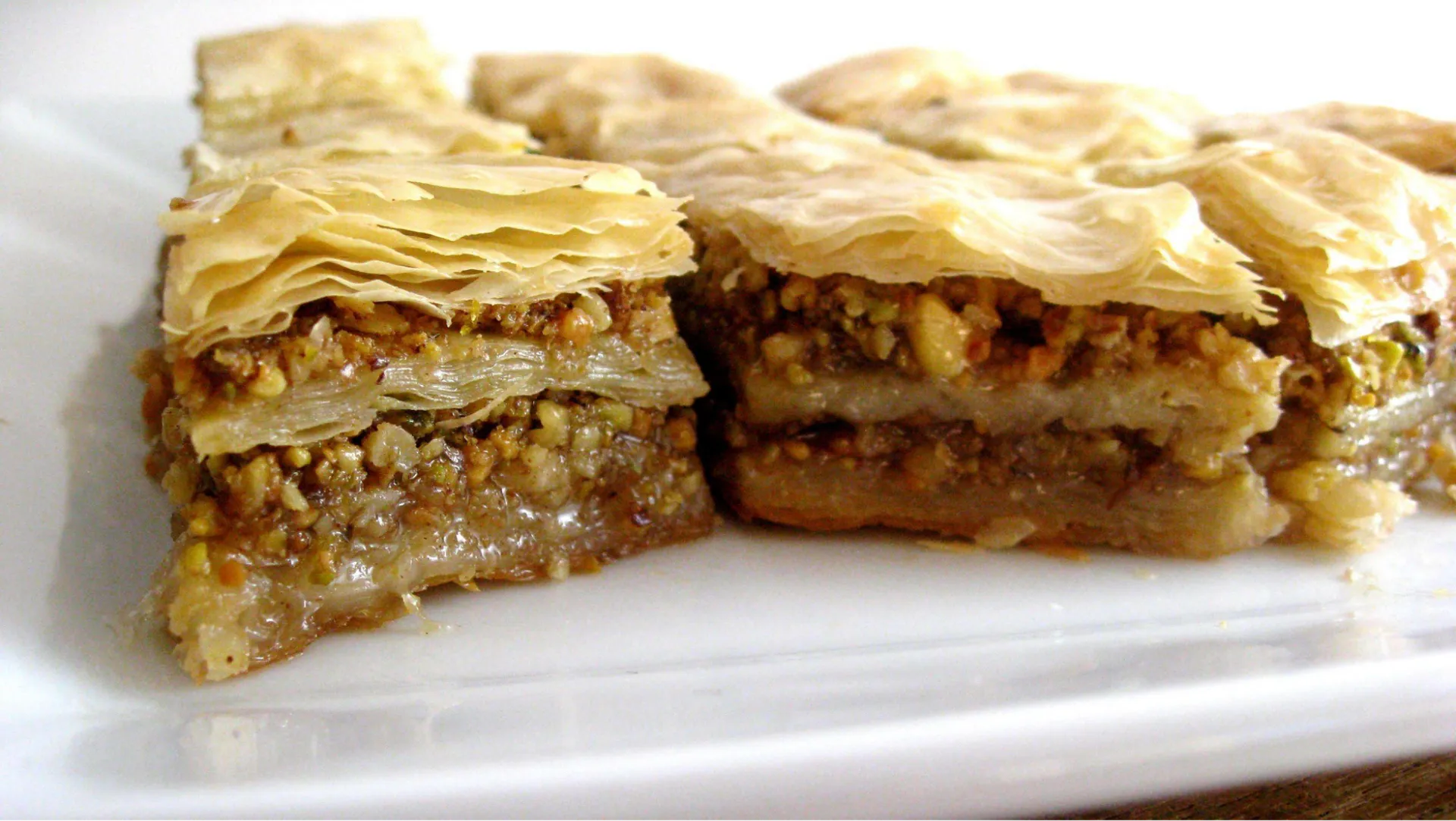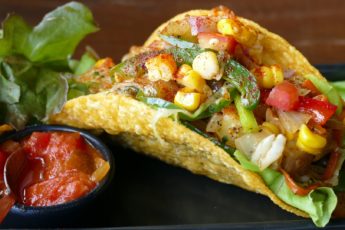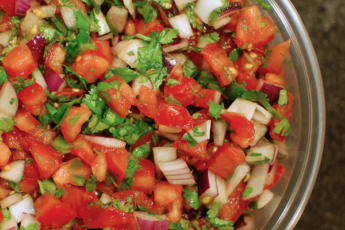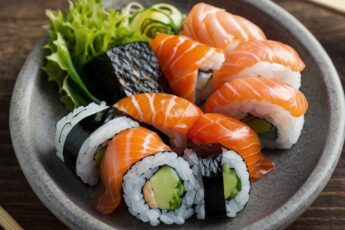Albanian Desserts
The sort of thing I love about Albanian desserts is how they combine Eastern and Western European culinary traditions to create unique flavor combinations you won’t find anywhere else in the world. These delicate sweet treats complement any meal or special occasion perfectly. Albania’s invaders left their mark on the country’s cuisine in the last several years. They brought new dessert recipes that became household staples.
Albanian traditional desserts tell stories of the country’s rich cultural heritage. Take Bakllava, a Turkish sweet that Albanians spell distinctively with double “l”. Trilece, also known as “three-milk cake,” shows an interesting path from Latin America to becoming one of Albania’s most popular treats. Revani adds to this sweet collection – a simple yet delicious syrup-soaked cake that combines flour with cornstarch or cornmeal, enhanced by lemon and vanilla flavors. Shendetlie holds a special place among Albania’s greatest desserts, and people serve it exclusively during special occasions. Albanian sweets range from syrup-soaked pastries to creamy puddings, and they give visitors an unmatched culinary experience.

Traditional Albanian Pastries
Traditional Albanian pastries tell stories of family recipes passed down through generations. They blend Ottoman, Mediterranean, and Balkan cooking styles. These mouthwatering treats show off Albania’s rich culture through special cooking methods and unique flavors. Let me tell you about some beloved Albanian pastries that locals and visitors can’t get enough of.
Bakllava: A holiday staple
Bakllava is the life-blood of Albanian holiday desserts. People make it during New Year’s to bring happiness and blessings. This layered filo pastry has deep roots in history and has become a comfort food in Albanian homes.
Real Albanian Bakllava uses many layers of buttered filo pastry with ground walnuts and cinnamon between them. The pastry turns golden brown in the oven, and bakers pour sweet syrup over it right away. This creates its special texture and taste. Many Albanian families like to use honey instead of sugar syrup, which makes their version taste richer.
The most important step in making Bakllava is keeping the filo pastry under a damp tea towel while putting it together. This stops it from drying out. Bakers also cut the pastry into diamond shapes before it goes in the oven. This helps keep the delicate layers from breaking later.
Tullumba: Fried and syrup-soaked
Sweet lovers in Albania can’t resist Tullumba. This fun dessert has deep-fried dough soaked in sweet syrup. The outside stays crunchy while the inside becomes soft and moist.
Making Tullumba starts with a dough like choux pastry that uses butter, water, sugar, flour, and eggs. Cooks pipe the dough through a star-tipped bag into hot oil until it turns golden brown. The hot pastries go straight into cold syrup, which helps them soak up the sweetness while staying crispy outside.
Turkish and Middle Eastern versions exist, but Albanian Tullumba stands out. The bite-sized pieces look like churros but taste completely different.
Petulla: Breakfast or dessert
Petulla shows how flexible Albanian cooking can be. This simple fried dough naturally moves from breakfast table to dessert plate, depending on what you serve it with.
The recipe needs just lukewarm water, yeast, sugar, flour, salt, and sometimes eggs to make a sticky batter. After 30 minutes of rest, the batter goes into hot oil until golden brown. Petulla tastes great with sweet toppings like powdered sugar or honey, but it works just as well with savory options like feta cheese.
Petulla means comfort food in Albanian culture. Home cooks love it because they don’t need to knead the dough. You’ll find people eating Petulla throughout Albania, Kosovo, Macedonia, and anywhere Albanian communities live.
Tespishte: A festive favorite
Tespishte means celebration in Albanian cooking. This special dessert comes out at weddings, family parties, and religious holidays like Eid, especially in Kosovo.
Bakers mix oil, milk, flour, and eggs, then bake it and coat it with sherbet while it’s still warm. Families often sprinkle crushed walnuts, pistachios, or almonds on top for extra crunch and flavor.
Tespishte stands out because of the patterns pressed into the dough before baking. Most people use triangle and dot designs, but some families pass down their own special patterns. The dessert turns golden in the oven, then soaks in sugar water. Bakers cut it into diamond shapes so the syrup can spread through every bite as it cools.

Classic Albanian Cookies
Albanian cookie traditions showcase an array of this Balkan nation’s culinary heritage. Sweet confections hold a special place in Albanian homes and appear at celebrations, holidays, and everyday gatherings. Albanian cookies stand apart from pastries with their unique textures and flavor profiles that evolved through centuries of cultural exchange and family tradition.
Sheqerpare: Almond and syrup delight
Sheqerpare means “sweet coins” in Albanian and ranks among the most beloved traditional Albanian desserts. These shortbread-type cookies soak in sugar syrup to create a perfect balance of textures – a crisp exterior yields to a melt-in-your-mouth interior.
Making the syrup needs careful attention and remains the trickiest part to get right. The syrup turns watery if not boiled long enough, but overcooking makes it harden like candy, leaving cookies trapped in an impenetrable sweet shell. Albanian home cooks suggest it’s better to undercook the syrup slightly.
The classic recipe mixes butter, sugar, egg yolks, flour, and baking soda into a crumbly dough that needs hand kneading. Golden-baked cookies receive a generous coating of vanilla and clove-infused syrup. Cities like Dibra and Korça have developed their own unique versions throughout the Balkans.
Gurabie: Buttery shortbread with a twist
Gurabie cookies (also known as Gurabija or Kurabie) taste and feel like scones, making them perfect with morning coffee or afternoon tea. These treats first appeared in Persia during the 7th century as sugar became accessible to more people, then spread across the Mediterranean region.
Albanian Gurabie combines yogurt, eggs, sugar, butter, baking soda, vanilla, and flour. Small walnut-sized dough balls crack distinctively while baking. Modern bakers add coconut, lemon zest, or cocoa powder to create new flavor combinations.
Each Albanian family has its own special recipe. Some use three eggs with seven tablespoons of sugar, while others add cornstarch and coconut for extra texture. Many families bake Gurabie for special occasions, though these treats stay fresh for days without getting hard.
Ballokume: The pride of Elbasan
Ballokume represents Elbasan’s signature cookie, a historic city in central Albania. These special treats show up during Dita e Verës (Spring Day), an Albanian pagan holiday celebrated every March 14. This local Elbasan tradition became a national holiday in 2004, making Ballokume popular across Albania.
The distinctive yet simple recipe uses butter, sugar, eggs, and cornflour – ingredients that come together through vigorous kneading. Traditional bakers use copper bowls because they believe the heat from kneading improves the dough’s texture. The physical effort needed often brings men into Albanian kitchens to help prepare Ballokume.
Local stories say the name came from a 16th-century Ottoman ruler of Elbasan who said “Është ba si llokume!” (“It’s as good as lokum!”) after trying these cornflour cookies. His words eventually shortened to “ballokume,” linking these beloved cookies forever to Albanian culture.
Beloved Albanian Cakes
Albanian sweet traditions center around delectable cakes that people traditionally served at special gatherings but now enjoy for everyday celebrations too. These original recipes create a perfect balance of sweetness and unique textures that showcase Albanian baking culture’s remarkable diversity.
Trilece: The three-milk wonder
Trilece stands as the crown jewel of Albanian desserts, with its name coming from the three types of milk in its recipe. The original version used goat, cow, and buffalo milk. Today’s recipe typically combines condensed milk, whole milk, and heavy cream to create an exceptionally moist texture that melts in your mouth.
This dessert’s roots trace back to the Ottoman era and share similarities with the Mexican Tres Leches cake. Bakers create a light, airy sponge cake and pierce it before pouring the milk mixture over the top. Albanian bakers make their version unique by adding a signature caramel topping that adds rich flavor depth.
Revani: A syrup-soaked semolina cake
Revani holds special meaning in Albanian homes as families pass down recipes through generations. This spongy cake soaks up sweet syrup for hours before serving, and bakers cut it into diamond shapes to show off its unique texture. Albanian revani is different from Greek and Turkish versions because it uses flour with cornstarch or cornmeal instead of semolina.
Albanian revani’s magic comes from its syrup preparation. The syrup features traditional flavors of lemon juice, lemon zest, cinnamon stick, and vanilla. Timing matters – families pour warm syrup over the cake and let it soak for at least six hours or overnight before serving.
Shendetlie: A walnut-rich treat
Shendetlie gets its name from the Albanian word for “health” (shëndet) and ranks among Albania’s most beloved cakes. This honey and walnut creation sits between a cake and biscuit. The dough bakes like a biscuit but transforms into a moist, cake-like dessert after soaking in sugar syrup.
Albanian families once saved shendetlie just for holidays, especially Christmas. The cake features plenty of walnuts, which families use either whole or ground based on their preference. Ground walnuts give the cake a darker color.
Qumeshtor: Simple milk-based cake
Qumeshtor shows Albanian home cooking at its finest by turning simple ingredients into something extraordinary. The name comes from “qumësht” (Albanian for milk), making milk its star ingredient. This straightforward recipe combines milk, eggs, sugar, butter, and flour into a batter that bakes into a creamy, irresistible dessert.
The preparation starts with beating eggs and sugar together, then adding melted butter, flour, and milk until the mixture becomes liquid. Bakers pour this batter into a buttered pie-pan and bake it until it turns caramel-colored. Albanian mothers know their dessert is ready when a toothpick comes out clean.
Albanian Puddings and Creamy Desserts
Albanian culinary creativity shines through creamy puddings with their smooth textures and comforting flavors. These desserts tell a story of centuries-old cultural exchange that created unique combinations loved across the region.
Sultjash: Rice pudding with cinnamon
Sultjash is Albania’s beloved version of rice pudding. The recipe calls for rice simmered in milk until it reaches a creamy, velvety texture. This simple dessert blends milk, rice, sugar, and aromatic spices like cinnamon and vanilla. Albanian families serve it warm or chilled, and often add fresh berries, almonds, or pistachios to create texture.
Turkish cuisine inspired Sultjash, but Albanians crafted their own unique version over time. The pudding works well as a comforting dessert and even makes a light breakfast choice, which shows its adaptability in Albanian food culture.
Ashure: Fruit and grain harmony
Ashure, also known as Noah’s Pudding, stands as one of the oldest Albanian desserts. Legend says Noah created this pudding on the ark using his remaining ingredients after the flood waters receded.
Albania’s version mixes whole grains (usually wheat or barley), chickpeas, white beans, dried fruits, nuts, and natural sweeteners like honey or sugar. Each family has its own recipe that might include dried figs, apricots, raisins, walnuts, and almonds. A touch of cinnamon and orange zest adds the final flavor.
Hasude: Cornstarch pudding with history
Hasude is Albania’s unique take on cornstarch-based pudding with Turkish roots. This recipe appears in many Albanian regions and creates a light yet satisfying dessert. The simple appearance hides complex flavors that surprise the taste buds.
The recipe needs cornstarch cooked with butter, sugar, and water until it thickens to pudding consistency. Albanian families prefer Hasude chilled, which makes it a refreshing treat during summer months.
Mualebi: Creamy Middle Eastern influence
Mualebi (or Muhallebi) reflects Middle Eastern influences in Albanian sweets. This rich pudding combines milk, sugar, and cornstarch, often with rose water or orange blossom water added. A sprinkle of crushed pistachios, walnuts, or ground cinnamon tops this silky-smooth dessert.
Persian in origin, this creamy treat spread throughout the region during Ottoman times and became part of Albania’s food heritage. Albanian families serve Mualebi at special events and religious celebrations, especially during Ramadan.
Other Unique Albanian Sweets
Albanian cuisine features several unique confections that go beyond typical dessert categories. These special Albanian sweets show how simple ingredients create amazing results. People usually make them during special occasions and religious celebrations.
Kadaif: Shredded filo with nuts
Kadaif, also called Kataifi or Kadayif, is a staple sweet at Albanian religious holidays and celebrations. This unique treat traces back to the 11th century Seljuk period. People originally made it with shredded dough baked in syrup and topped with crushed nuts. Albanian families prepare this festive dessert using pastry threads that look like thin spaghetti strands.
Making kadaif starts with separating the fine strands and coating them with melted butter. The next step involves layering them with nuts—usually walnuts, almonds, or pistachios. The pastry bakes until golden, then gets a generous soak in cooled sugar syrup. Albanian kadaif’s signature comes from its crispy top layer and soft, sticky bottom.
Hallva: Dense and nutty
Hallva is one of Albania’s most traditional sweets. It brings communities together as families share portions with their neighbors whenever they make it. Unlike light cakes or sticky pies, hallva has a dense, crumbly texture that melts right in your mouth.
The real Albanian recipe mixes flour with butter or oil, sugar, and water. You start by heating butter in a pan, then slowly add flour. The mixture cooks on low heat for about 40 minutes until it turns golden. Many families improve their hallva by adding chopped walnuts for extra crunch and flavor.
Kabuni: Rice with mutton broth and raisins
Kabuni might be the most unusual mix in Albanian sweet cuisine—rice cooked with mutton broth and raisins. This dessert shows how Albanians can blend unexpected flavors into something amazing.
The recipe starts with cooking rice in butter, mutton broth, raisins, and salt until the rice soaks up all the flavors. Some versions add cinnamon, almonds, cloves, and brown sugar to make it more complex. The end result is a cold, pudding-style dessert that’s really creamy. Even with its unusual ingredients, kabuni creates a surprisingly tasty flavor that has earned its place among beloved Albanian sweets.
Summing all up
Albanian desserts are evidence of the country’s rich cultural array that blends Eastern and Western European influences into something special. These sweet treasures have evolved through generations of family recipes. Each recipe tells stories of cultural exchange and accepts new ideas.
The diversity of Albanian sweets shines through their vast collection. Albanian dessert culture has something for every taste – from syrup-soaked pastries like Bakllava and Tullumba to buttery cookies like Sheqerpare and Gurabie. Cakes like Trilece and Revani show how basic ingredients become extraordinary treats through traditional methods.
Albanian desserts know how to adapt while keeping their traditional roots. Many recipes came from other places – Turkish Bakllava, Latin American Trilece, Persian Mualebi. Yet Albanians have reimagined these sweets with their own local twists. Familiar treats often surprise people with unexpected flavors or unique Albanian preparation methods.
Key ingredients like walnuts, honey, butter, and cinnamon create a common thread throughout Albanian sweet cuisine. This creates a unified culinary language despite the variety. The method of soaking baked goods in syrup appears often, showing how deeply this technique has rooted itself in Albanian food culture.
Albanian desserts tell stories of celebration, community, and heritage. People enjoy them during religious holidays, family gatherings, or with their daily coffee. These sweet creations strengthen cultural bonds and delight the senses. Learning about Albanian desserts is more than just discovering new tastes – it gives us a glimpse into Albanian culture’s heart.
Here are some FAQs about famous Albanian desserts:
What is the Albanian pastry dessert?
Among traditional Albanian desserts, baklava stands out as the most famous pastry, featuring layers of phyllo dough with nuts and syrup. Another beloved Albanian desserts name is revani, a semolina cake soaked in sweet syrup. These easy Albanian desserts showcase the country’s Ottoman influences while maintaining unique local variations.
What is the famous Albanian chocolate?
While Albania has several chocolate brands, the most distinctive sweet is not chocolate but rather traditional Albanian desserts like trilece. The Albanian desserts names include various milk-based treats that are more characteristic than chocolate. For chocolate lovers, local versions of European-style chocolates are available, but the trilece Albanian desserts remain more culturally significant.
What is the Albanian dessert with milk?
Trilece is the most famous Albanian dessert with milk, consisting of a sponge cake soaked in three kinds of milk. This traditional Albanian dessert has become one of the most popular easy Albanian desserts to make at home. Other Albanian desserts names featuring milk include qumeshtor, a baked custard pudding.
What is the most traditional Albanian dish?
While not a dessert, byrek is Albania’s most traditional savory dish, though sweet versions exist among Albanian desserts. For sweets, traditional Albanian desserts like ballokume (a corn flour cookie) date back centuries. These easy Albanian desserts and pastries form an important part of the country’s culinary heritage alongside main dishes.
What is the traditional pie of Albania?
Byrek is Albania’s traditional savory pie, while sweet versions appear among traditional Albanian desserts. For dessert pies, Albanian desserts names include kulaç, a sweet cheese pie. These easy Albanian desserts showcase the country’s love for both savory and sweet pastry creations.
What are Hungarian pastries?
While discussing Albanian desserts, it’s worth noting Hungarian pastries like strudel differ from traditional Albanian desserts. Albanian desserts names highlight local specialties like trilece rather than Central European pastries. Both cuisines feature milk-based treats, but trilece Albanian desserts have a distinct Mediterranean character compared to Hungarian creations.



